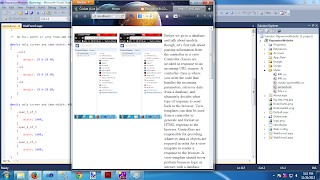CSS :-
<style type="text/css">
/* popup_box DIV-Styles*/#popup_box
{
display: none; /* Hide the DIV */
position: fixed;
_position: absolute; /* hack for
internet explorer 6 */
height: 175px;
width: 400px;
background: #FFFFFF;
left: 300px;
top: 150px;
z-index: 100; /* Layering ( on-top of others), if you have lots of layers:
I just maximized, you can change it yourself */
margin-left: 15px; /* additional
features, can be omitted */
border: 2px solid #ff0000;
padding: 15px;
font-size: 15px;
-moz-box-shadow: 0 0 5px #ff0000;
-webkit-box-shadow: 0 0 5px #ff0000;
box-shadow: 0 0 5px #ff0000;
}
#container
{
background: #d2d2d2; /*Sample*/
width: 100%;
height: 100%;
}
a
{
cursor: pointer;
text-decoration: none;
}
/* This is for the positioning of
the Close Link */#popupBoxClose
{
font-size: 20px;
line-height: 15px;
right: 5px;
top: 5px;
position: absolute;
color: #6fa5e2;
font-weight: 500;
}
</style>
Jquery :-
<script src="http://jqueryjs.googlecode.com/files/jquery-1.2.6.min.js" type="text/javascript"></script>
<script type="text/javascript">
$(document).ready(function () {
// When site loaded, load the Popupbox First
loadPopupBox();
$('#popupBoxClose').click(function () {
unloadPopupBox();
});
$('#container').click(function () {
unloadPopupBox();
});
function unloadPopupBox() { // TO Unload the Popupbox
$('#popup_box').fadeOut("slow");
$("#container").css({ // this is just for style
"opacity": "1"
});
}
function loadPopupBox() { // To Load the Popupbox
$('#popup_box').fadeIn("slow");
$("#container").css({ // this is just for style
"opacity": "0.3"
});
}
});
</script>
ASPX CODE :-
<div id="popup_box">
<h1>
<table class="style1">
<tr>
<td>
<asp:Label ID="lblCountry" runat="server" Text="Country"></asp:Label> </td>
<td>
<asp:TextBox ID="txtCountry" runat="server"></asp:TextBox> </td>
</tr>
<tr>
<td>
<asp:Label ID="lblState" runat="server" Text="State"></asp:Label> </td>
<td>
<asp:TextBox ID="txtState" runat="server"></asp:TextBox> </td>
</tr>
<tr>
<td>
<asp:Label ID="lblCity" runat="server" Text="City"></asp:Label> </td>
<td>
<asp:TextBox ID="txtCity" runat="server"></asp:TextBox> </td>
</tr>
<tr>
<td>
</td>
<td>
<asp:Button ID="btnsa" runat="server" Text="Button" OnClientClick="save();" /> </td>
</tr>
</table></h1>
<a id="popupBoxClose">Close</a>
</div>
POPUP DIV LOOK LIKE THIS :-
<style type="text/css">
/* popup_box DIV-Styles*/#popup_box
{
display: none; /* Hide the DIV */
position: fixed;
_position: absolute; /* hack for
internet explorer 6 */
height: 175px;
width: 400px;
background: #FFFFFF;
left: 300px;
top: 150px;
z-index: 100; /* Layering ( on-top of others), if you have lots of layers:
I just maximized, you can change it yourself */
margin-left: 15px; /* additional
features, can be omitted */
border: 2px solid #ff0000;
padding: 15px;
font-size: 15px;
-moz-box-shadow: 0 0 5px #ff0000;
-webkit-box-shadow: 0 0 5px #ff0000;
box-shadow: 0 0 5px #ff0000;
}
#container
{
background: #d2d2d2; /*Sample*/
width: 100%;
height: 100%;
}
a
{
cursor: pointer;
text-decoration: none;
}
/* This is for the positioning of
the Close Link */#popupBoxClose
{
font-size: 20px;
line-height: 15px;
right: 5px;
top: 5px;
position: absolute;
color: #6fa5e2;
font-weight: 500;
}
</style>
Jquery :-
<script src="http://jqueryjs.googlecode.com/files/jquery-1.2.6.min.js" type="text/javascript"></script>
<script type="text/javascript">
$(document).ready(function () {
// When site loaded, load the Popupbox First
loadPopupBox();
$('#popupBoxClose').click(function () {
unloadPopupBox();
});
$('#container').click(function () {
unloadPopupBox();
});
function unloadPopupBox() { // TO Unload the Popupbox
$('#popup_box').fadeOut("slow");
$("#container").css({ // this is just for style
"opacity": "1"
});
}
function loadPopupBox() { // To Load the Popupbox
$('#popup_box').fadeIn("slow");
$("#container").css({ // this is just for style
"opacity": "0.3"
});
}
});
</script>
ASPX CODE :-
<div id="popup_box">
<h1>
<table class="style1">
<tr>
<td>
<asp:Label ID="lblCountry" runat="server" Text="Country"></asp:Label> </td>
<td>
<asp:TextBox ID="txtCountry" runat="server"></asp:TextBox> </td>
</tr>
<tr>
<td>
<asp:Label ID="lblState" runat="server" Text="State"></asp:Label> </td>
<td>
<asp:TextBox ID="txtState" runat="server"></asp:TextBox> </td>
</tr>
<tr>
<td>
<asp:Label ID="lblCity" runat="server" Text="City"></asp:Label> </td>
<td>
<asp:TextBox ID="txtCity" runat="server"></asp:TextBox> </td>
</tr>
<tr>
<td>
</td>
<td>
<asp:Button ID="btnsa" runat="server" Text="Button" OnClientClick="save();" /> </td>
</tr>
</table></h1>
<a id="popupBoxClose">Close</a>
</div>
POPUP DIV LOOK LIKE THIS :-


